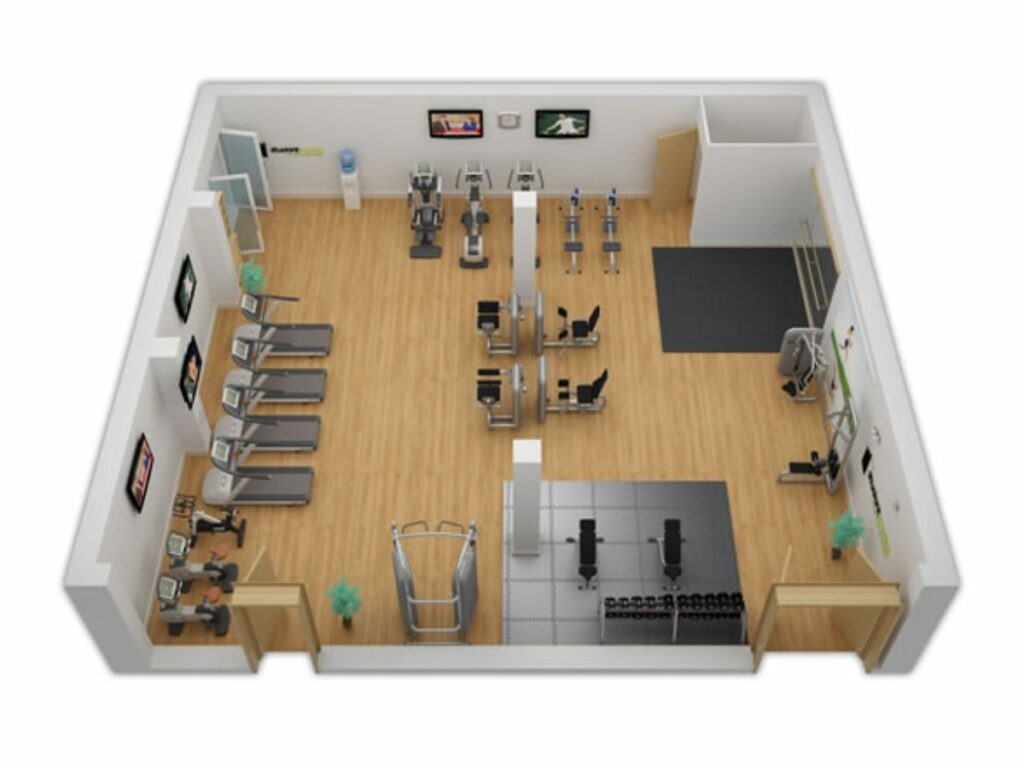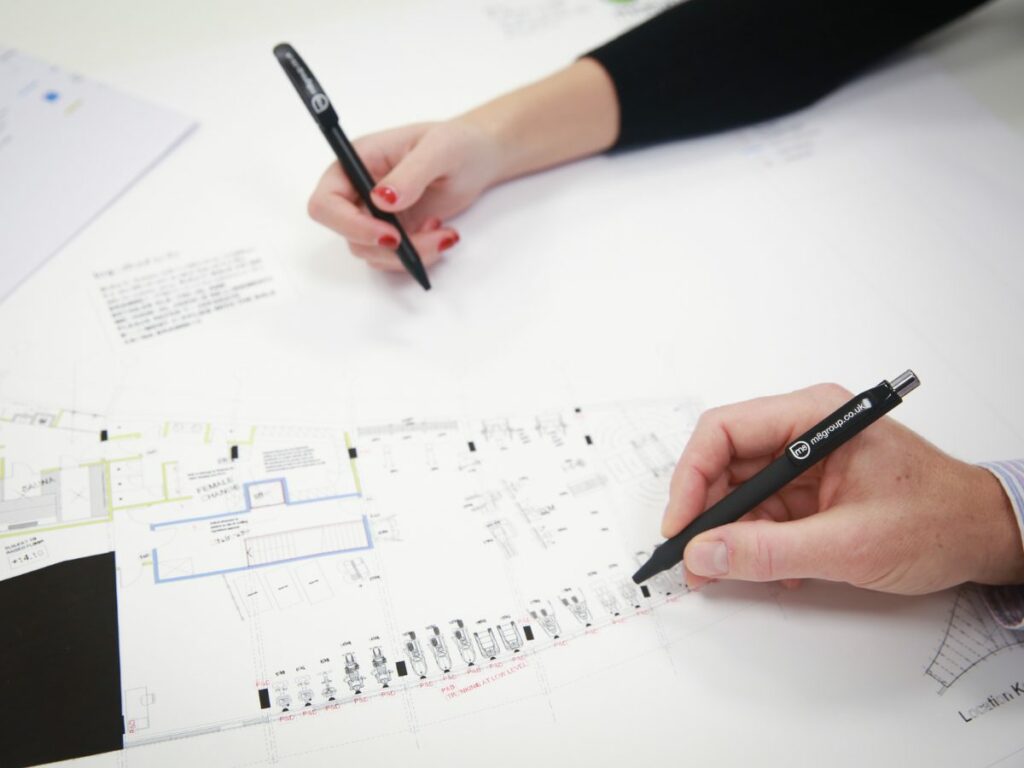Ever wondered, “How long does it take to build a gym from scratch?” Building a gym is a comprehensive process, fraught with numerous considerations from conceptualization to execution. It’s not as simple as securing a space and filling it with equipment; in fact, it’s a strategic blend of planning, construction, equipment procurement, and marketing. What do you need to open a gym?
Typically, this process spans across several months, varying significantly based on several key factors. This blog post aims to demystify the process, breaking down the timeline into manageable phases, and offering practical tips to expedite it.
Read on to gain insights into planning the gym of dreams and make that leap into the fitness industry.
Table of Contents
1. Understanding the Gym Building Process
Navigating the gym building process can be a daunting task. It’s a journey with numerous steps that must be executed meticulously. The following aspects shed light on each of these stages:
Conceptualizing the Gym Space
The initiation stage is all about visualizing the gym space. This includes finalizing the layout for equipment, deciding on the interior design, and setting the tone for the overall ambiance of the gym. It’s a time of creativity and innovation, where one gets to lay the foundation for the dream gym. The duration of this phase depends on individual decision-making speed, though it typically spans a few weeks.

Acquiring Permissions
Following the conceptualization, the next step is to secure all the required permissions and permits from local authorities. This involves submitting necessary documents and adhering to specific zoning laws and regulations. The timeframe for this phase is subjective to the local governance structure and bureaucracy, but it can range anywhere from several weeks to a couple of months.
Selecting Equipment and Suppliers
Purchasing gym equipment is a critical phase that directly impacts the gym’s functionality and member experience. Gym owners need to research various suppliers, compare equipment features, prices, warranties, and then finalize their orders. In this step, choosing a reliable supplier like Yanre Fitness, known for its wide range of high-quality fitness equipment, can save considerable time and effort.
Contracting Construction
Post finalizing the equipment, it’s time to get into action. The construction phase kicks in with the hiring of contractors. Anyone will agree that they will be responsible for bringing the gym’s blueprint to life. Depending on the gym’s size, the construction process can last from one to three months.
Installation and Finishing
After the basic construction, it’s time for installation of the equipment and finishing touches. This includes painting, setting up the lighting, laying the flooring, and setting up the lockers. Also, installing the ordered gym equipment. This stage can take about two to four weeks.
The table below outlines the stages and tasks involved in the installation and finishing of a gym, including equipment setup, painting, lighting design, flooring installation, locker room setup, and final quality checks. Discover the essential steps to create a functional and visually appealing gym environment that meets safety standards and member expectations.
| Installation and Finishing Stages | Description |
| Equipment Delivery and Setup | This stage involves the delivery and installation of the ordered gym equipment, ensuring proper placement, assembly, and functionality of each piece to create a functional and well-equipped gym environment. |
| Painting and Wall Finishing | Painting and wall finishing are crucial for creating an aesthetically pleasing gym space. This includes selecting suitable colors, applying paint or wallpaper, and ensuring a clean and finished look for the walls, creating a welcoming atmosphere. |
| Lighting Setup and Design | Proper lighting is essential for creating a well-lit and visually appealing gym. This stage involves setting up adequate lighting fixtures, considering factors such as brightness, color temperature, and energy efficiency to optimize the gym’s ambiance and functionality. |
| Flooring Installation and Finishing | Installing and finishing the gym flooring is crucial for safety, durability, and aesthetics. This includes selecting appropriate flooring materials, such as rubber, vinyl, or hardwood, and ensuring proper installation and finishing techniques to create a level, non-slip, and visually appealing gym floor. |
| Locker Room Setup and Organization | Setting up the locker room involves installing lockers, benches, and other necessary amenities to create a functional and organized space for members to store their belongings. This stage also includes ensuring proper ventilation, cleanliness, and a secure environment within the locker room area. |
| Final Inspection and Quality Check | Before officially opening the gym, a final inspection and quality check should be conducted. This involves assessing the overall installation and finishing work, ensuring that everything meets the desired standards, safety regulations, and member expectations for a successful gym opening. |
Launch Preparation
The final stage is all about preparing for the grand opening. This includes hiring staff, setting up membership plans, and marketing the gym. The duration of this phase is primarily determined by the individual’s marketing strategy and can take a few weeks.
Finalizing the Offerings and Pricing
The gym’s services and pricing play a significant role in attracting and retaining members. Finalizing these aspects requires a deep understanding of the market and competitors. Gym owners need to decide on the variety of services they plan to offer. Moreover, pricing strategy needs to be designed keeping in mind factors such as costs, competitors’ pricing, and the perceived value of the services.
2. Detailed Breakdown of Gym Construction Timeline
A more profound understanding of the timeline can be gained by dissecting the gym construction process into finer details. Here are the micro-stages involved:
Initial Planning
The journey of gym construction commences with a robust planning phase. It sets the tone for the entire project by identifying the gym’s size, the target demographic, the types of services offered, and the ultimate vision for space. It also involves outlining a budget, shortlisting potential locations, and laying out preliminary design ideas.
Design Phase
Transitioning from broad strokes to intricate details, the design phase breathes life into the gym’s blueprint. It involves meticulously planning the placement of each element – from weight machines to treadmills, from locker rooms to lounging areas. Every tiny detail is deliberated upon to ensure maximum space optimization, aesthetic appeal, and user comfort.

Permit Acquisition
Securing permissions and permits forms the next crucial step in this journey. Every region has specific zoning laws and building regulations that need to be complied with. The necessary paperwork needs to be submitted and approved by the relevant authorities before any construction can commence. Believe me, this phase can be a test of patience due to varying procedures and may span from a few weeks to several months.
Construction Phase
Once the green light for construction is received, the blueprint starts to evolve into a tangible structure. This phase involves site preparation, laying down the foundation, building walls, installing windows and doors, and everything else that physically constitutes the gym space. It also requires constant supervision to ensure the construction adheres to the approved design.
Installation Phase
The installation phase is akin to adding character to an empty canvas. It is during this stage that the gym space gets filled with equipment, lighting fixtures are installed, flooring is laid out, lockers are set up, and the interior decor elements are put in place. This phase also involves the installation of HVAC systems, plumbing, and electrical wiring. Ensuring all elements are installed safely and functioning correctly is crucial.
Pre-Launch Phase
Once the gym is fully set up, the pre-launch phase begins. It involves hiring staff, developing a marketing strategy, creating a website, setting up an online presence, planning the launch event, and pre-selling memberships. This phase is critical as it sets the pace for the gym’s market entry and customer acquisition. It can take anywhere from two weeks to a month, depending on the strategies employed.
Final Inspection and Obtaining Certificate of Occupancy
After the gym is fully built and equipped, it must pass a final inspection to ensure it complies with all building codes and safety regulations. This inspection is usually conducted by local authorities or a designated inspector. Upon successful inspection, a Certificate of Occupancy (CO) is issued, officially allowing the gym to open for business. The timeline for this process can vary, typically ranging from a few days to several weeks.
3. 7 Factors Affecting the Timeline
The timeline of gym construction doesn’t exist in a vacuum. Numerous external and internal factors interplay to shape the overall schedule. Here’s a look at some of the influential elements:
#1 Legal and Regulatory Factors
The gym construction timeline is significantly impacted by the local laws and regulations. Every region has its own set of zoning laws, building codes, and safety regulations that need to be adhered to. The process of obtaining the necessary permits and approvals from the relevant authorities can be lengthy and unpredictable. Any delay or complications in this phase can set back the overall timeline by weeks, if not months.
#2 Size and Complexity of the Gym
The scale and complexity of the gym project are directly proportional to the timeline. Larger gyms demand more construction time and more extensive installations. Similarly, the complexity of the design also impacts the timeline. For instance, a gym with a simple design and layout can be built faster compared to a gym with intricate architectural features.
#3 Selection and Delivery of Equipment
The procurement of fitness equipment is a pivotal stage that significantly influences the gym construction timeline. This phase necessitates careful supplier research, product comparison, and order placement. Partnering with a trustworthy supplier like Yanre Fitness can expedite this process. Their strong reputation in the fitness industry makes them an ideal choice for gym owners embarking on their gym-building journey.
#4 Construction Challenges
Despite meticulous planning, unexpected challenges can arise during the construction phase. Unpredictable weather conditions, unavailability of construction materials, errors in construction, or last-minute design changes can lead to delays. The more the complications, the longer the construction phase stretches, thereby lengthening the overall timeline.
#5 Staff Recruitment and Training
Recruiting a well-trained and competent staff is another crucial aspect that impacts the gym’s opening timeline. Once the construction and installation phases are nearing completion, the recruitment process for gym instructors, personal trainers, receptionists, and cleaning staff must begin. After the hiring, there’s also a need for orientation and training, which further adds to the timeline.

#6 Marketing and Promotion Strategy
The marketing strategy is another pivotal factor. Gym owners must design and execute a marketing and promotion strategy for their pre-launch and grand opening. This includes creating an online presence, hosting promotional events, offering pre-booking of memberships, and more. Based on my experience, the duration of this phase largely depends on the strategies employed and the local market dynamics.
#7 Economic and Market Conditions
Believe it or not, the broader economic and market conditions can significantly impact the gym construction timeline. In a booming economy, construction, equipment, and labor costs may be higher, potentially extending the timeline as budgets need to be managed carefully. Additionally, during periods of high demand, suppliers, contractors, and labor may be busier, which could lead to delays.
4. Practical Tips to Speed Up the Process
While the intricacies of gym construction may seem overwhelming, there are effective ways to streamline the process and reduce timeframes. Here are several practical tips:
Engage a Professional Team Early
Getting architects, interior designers, and fitness consultants onboard from the get-go can save substantial time. These experts can guide through the planning and designing phases more efficiently, reducing the chances of costly mistakes or redesigns later on. Moreover, their seasoned experience can help in making informed decisions promptly, thereby accelerating the initial phases.
Detailed Planning
In-depth planning is key to speed up the gym building process. A comprehensive plan should detail every aspect of the gym, from the layout design, equipment selection, to staff recruitment strategies. This helps in visualizing potential challenges and finding solutions in advance, hence saving valuable time.
Select Reliable Equipment Suppliers
According to Winman, good working relationships with suppliers will not only deliver cost savings, they will reduce availability problems, delays and quality issues. These suppliers should not only provide top-quality fitness equipment but also guarantee timely delivery. Delays in equipment delivery can significantly stall the gym’s opening timeline. Therefore, it is advisable to opt for suppliers known for their prompt service.
Prompt Start on Permit Acquisition Process
The process of securing the necessary permits and approvals can be long and uncertain. To mitigate the risk of delays, it is advisable to initiate the permit acquisition process as early as possible. This proactive approach ensures that even if there are bureaucratic hitches, the overall timeline won’t be drastically affected.
Allocate Time for Unexpected Delays
Despite the most meticulous planning, unexpected delays are often inevitable in any construction project. It could be due to adverse weather conditions, unexpected site issues, or a change in local regulations. Building a buffer into the timeline to account for such unforeseen setbacks can help keep the project on schedule.
Streamlined Recruitment Process
Staff recruitment and training is another phase that can take up a significant chunk of time. Creating a streamlined recruitment process can help speed up this phase. This could include developing detailed job descriptions, planning an efficient interview process, and having an effective training program in place.
Robust Marketing and Promotion Strategy
A comprehensive marketing and promotion strategy prepared well in advance can expedite the pre-launch phase. This includes setting up a website, establishing a social media presence, hosting promotional events, and offering early bird membership deals. All of these marketing efforts should ideally begin a few weeks before the gym is set to open.
Regular Communication and Coordination
According to an article from Indeed, good communication is an important component, allowing projects to progress smoothly and on time. It ensures team members are aligned on project goals and understand exactly what’s expected of them. Regular meetings, updates, and prompt decision-making can significantly expedite the process and prevent any miscommunication or delays.
Embrace Technology
From opening a gym and designing the gym layout using advanced software to managing the project timeline through project management tools, technology can enhance efficiency and accuracy. Using digital platforms can save considerable time. For instance, digital recruitment platforms can expedite the hiring process, while social media and email marketing can make promotional activities more efficient.
5. Conclusion
Constructing a gym is not just about assembling fitness equipment in a spacious area. It is an intricate process, meticulously stitched together over several months, to create an environment that promotes health, wellness, and community. However, with the right understanding, planning, and implementation, the gym building process can be navigated smoothly.
Consider tying up with a reputable partner, like Yanre Fitness, for quality gym equipment, to further ensure that the gym stands out in terms of quality, design, and functionality. We stand committed to making the gym-building journey easier for entrepreneurs by providing world-class equipment within promised timelines. Contact us today, let’s make fitness accessible and appealing to all.
Related articles:








